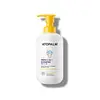What's inside
What's inside
 Key Ingredients
Key Ingredients

No key ingredients
 Benefits
Benefits

 Concerns
Concerns

 Ingredients Side-by-side
Ingredients Side-by-side

Water
Skin ConditioningLauryl Hydroxysultaine
CleansingDisodium Lauryl Sulfosuccinate
CleansingSodium Lauryl Glucose Carboxylate
CleansingLauryl Glucoside
CleansingSodium Chloride
MaskingDisodium Cocoyl Glutamate
CleansingPolyquaternium-22
Glyceryl Glucoside
HumectantCitric Acid
BufferingPhenethyl Alcohol
MaskingTrihydroxystearin
Skin ConditioningParfum
MaskingCaprylyl Glycol
EmollientGuar Hydroxypropyltrimonium Chloride
Skin ConditioningPanthenol
Skin ConditioningSodium Phytate
Glycerin
HumectantGlucose
HumectantButylene Glycol
HumectantHexylene Glycol
EmulsifyingArgania Spinosa Kernel Oil
EmollientSodium Citrate
BufferingBiotin
AntiseborrhoeicMyristoyl/Palmitoyl Oxostearamide/Arachamide Mea
Skin ConditioningRosa Davurica Bud Extract
AntioxidantCamellia Sinensis Leaf Extract
AntimicrobialLigularia Fishceri Leaf Extract
Skin ConditioningPropanediol
SolventSaccharide Isomerate
HumectantWater, Lauryl Hydroxysultaine, Disodium Lauryl Sulfosuccinate, Sodium Lauryl Glucose Carboxylate, Lauryl Glucoside, Sodium Chloride, Disodium Cocoyl Glutamate, Polyquaternium-22, Glyceryl Glucoside, Citric Acid, Phenethyl Alcohol, Trihydroxystearin, Parfum, Caprylyl Glycol, Guar Hydroxypropyltrimonium Chloride, Panthenol, Sodium Phytate, Glycerin, Glucose, Butylene Glycol, Hexylene Glycol, Argania Spinosa Kernel Oil, Sodium Citrate, Biotin, Myristoyl/Palmitoyl Oxostearamide/Arachamide Mea, Rosa Davurica Bud Extract, Camellia Sinensis Leaf Extract, Ligularia Fishceri Leaf Extract, Propanediol, Saccharide Isomerate
Ingredients Explained
These ingredients are found in both products.
Ingredients higher up in an ingredient list are typically present in a larger amount.
Caprylyl Glycol is a humectant and emollient, meaning it attracts and preserves moisture.
It is a common ingredient in many products, especially those designed to hydrate skin. The primary benefits are retaining moisture, skin softening, and promoting a healthy skin barrier.
Though Caprylyl Glycol is an alcohol derived from fatty acids, it is not the kind that can dry out skin.
This ingredient is also used as a preservative to extend the life of products. It has slight antimicrobial properties.
Learn more about Caprylyl GlycolGlycerin is already naturally found in your skin. It helps moisturize and protect your skin.
A study from 2016 found glycerin to be more effective as a humectant than AHAs and hyaluronic acid.
As a humectant, it helps the skin stay hydrated by pulling moisture to your skin. The low molecular weight of glycerin allows it to pull moisture into the deeper layers of your skin.
Hydrated skin improves your skin barrier; Your skin barrier helps protect against irritants and bacteria.
Glycerin has also been found to have antimicrobial and antiviral properties. Due to these properties, glycerin is often used in wound and burn treatments.
In cosmetics, glycerin is usually derived from plants such as soybean or palm. However, it can also be sourced from animals, such as tallow or animal fat.
This ingredient is organic, colorless, odorless, and non-toxic.
Glycerin is the name for this ingredient in American English. British English uses Glycerol/Glycerine.
Learn more about GlycerinLauryl Glucoside sugar- and lipid-based cleansing agent. It is created from glucose and lauryl alcohol.
This ingredient is a surfactant, making it easier to rinse oil, dirt, and other pollutants away.
A British study found lauryl glucoside to cause skin sensitivity for some people. We recommend speaking with a professional if you have concerns.
Other names for this ingredient include "Lauryl Polyglucose", "Lauryl glycoside", and "D-Glucopyranoside".
Learn more about Lauryl GlucosidePanthenol is a common ingredient that helps hydrate and soothe the skin. It is found naturally in our skin and hair.
There are two forms of panthenol: D and L.
D-panthenol is also known as dexpanthenol. Most cosmetics use dexpanthenol or a mixture of D and L-panthenol.
Panthenol is famous due to its ability to go deeper into the skin's layers. Using this ingredient has numerous pros (and no cons):
Like hyaluronic acid, panthenol is a humectant. Humectants are able to bind and hold large amounts of water to keep skin hydrated.
This ingredient works well for wound healing. It works by increasing tissue in the wound and helps close open wounds.
Once oxidized, panthenol converts to pantothenic acid. Panthothenic acid is found in all living cells.
This ingredient is also referred to as pro-vitamin B5.
Learn more about PanthenolChances are, you eat sodium chloride every day. Sodium Chloride is also known as table salt.
This ingredient has many purposes in skincare: thickener, emulsifier, and exfoliator.
You'll most likely find this ingredient in cleansers where it is used to create a gel-like texture. As an emulsifier, it also prevents ingredients from separating.
There is much debate on whether this ingredient is comedogenic. The short answer - comedogenic ratings don't tell the whole story. Learn more about comegodenic ratings here.
The concensus about this ingredient causing acne seems to be divided. Research is needed to understand if this ingredient does cause acne.
Scrubs may use salt as the primary exfoliating ingredient.
Learn more about Sodium ChlorideWater. It's the most common cosmetic ingredient of all. You'll usually see it at the top of ingredient lists, meaning that it makes up the largest part of the product.
So why is it so popular? Water most often acts as a solvent - this means that it helps dissolve other ingredients into the formulation.
You'll also recognize water as that liquid we all need to stay alive. If you see this, drink a glass of water. Stay hydrated!
Learn more about Water